Breeds of small hamsters and features of caring for them
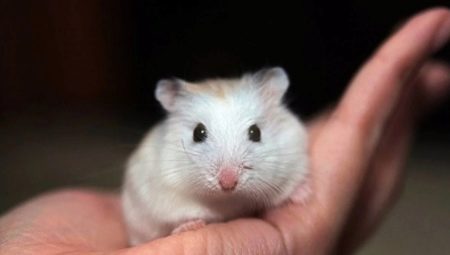
There are quite a few varieties of hamsters. In addition to the standard breeds, there are also small varieties. Dwarf rodents are very mobile, mischievous animals. Small domesticated hamsters are not a separate species, this class consists of dwarf representatives of various breeds.


Peculiarities
Small hamsters grow no more than 10 cm in length and weigh about 50 grams. They live on average 2-3 years, although the life expectancy of some may be 4 years. The color of the coat depends on the breed: it varies from light, gray or brownish to darker, with a pronounced stripe along the back. Small hamsters are distinguished by the absence of the characteristic odor characteristic of their large relatives. They do well in captivity and breed normally.

For one litter, the female brings on average 6–12 babies. The crumbs are very energetic, nimble, they cannot be left unattended outside the cage - they will run away right there. You also need to be very careful with them so that they do not fall and damage yourself.
After acquiring the animal, you cannot immediately pick it up - you must give it time to adapt.
Hamsters are gradually tamed and love to be stroked and caressed.


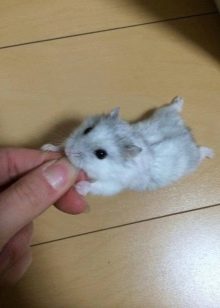
Their fur is very soft and delicate, extremely pleasant to the touch. Having become tame, the hamster will be happy to climb on you and can fall asleep in the palm of your hand. But do not squeeze them - they can bite. Hamsters do not like noise, because they are distinguished by their keen hearing. But their eyesight is bad, for recognition they use the sense of smell.


Breeds
Dwarf hamsters come in several breeds, differing mainly in coat color, and they are associated with excessive activity.
Dzungarian
The Dzungarian hamster belongs to the most famous small breed pets. The rodent also lives in the wild: on the Asian steppe plains and in deserts. Representatives of this species are very contactable and not indifferent to attention. Dzungarik, as it is also called, has a thick gray coat with a dark stripe along the entire length of the back, and a white tummy. Hamsters weigh only 35-60 grams and are 5-10 cm in size.


The low legs of the animals are covered with short light hairs, and they also have a tiny tail. The muzzle is slightly elongated, with dark beady eyes. By color, they are divided into standard (gray-brown with a white belly), sapphire (gray wool with a bluish tint and a white belly), pearls (milky with gray tints), mandarin (light brown wool shimmers with a light orange tint).
The life span of Dzungarian hamsters is from 2 to 4 years, with appropriate care. Representatives of this breed can change color, by winter their coat becomes lighter. The animals are capable of mating as early as 4–6 weeks.

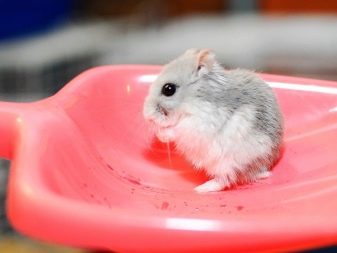
In the natural environment, they acquire offspring from spring to autumn, they can reproduce in the cage all year round. Up to 11 babies appear at a time, pregnancy lasts 21-26 days.


Taylor's hamster
Taylor's hamster measures no more than 6 cm, although it looks quite puffy. The coat is dense, with an uneven color: the chest and belly are white, and the head and back are brownish. Tiny ears, also overgrown with hair, are almost invisible, as is the miniature tail. The eyes are black with white speckled eyebrows, the nose is rosy. Taylor's hamsters breed all year round.

The duration of the gestation period is about 20-30 days, the offspring is from one to five crumbs, weighing only one gram. On the twentieth day, the cubs can live separately. The animals become sexually mature at 10–12 weeks. The life cycle lasts 1.5-3 years.


Hamster Campbell
Campbell's hamster is only one representative of small hamsters, which has different colors: white, black, light brown. The body of the animal is rounded, it can reach up to 10 cm in length, weight is about 25 g. The tail is very short, the ears are pointed, the base of the legs is covered with wool. The front legs have 4 toes, and the hind legs have 5. For one pregnancy at 18–22 days, 4–9 babies appear. Campbell's hamster lives 1–2 years.

Roborovsky's hamster
The smallest breed in the world, its representatives are 4.5-5 cm in size and weigh 20-25 grams. The fur is fluffy, a tiny tail is completely lost in it. Slightly rounded ears are located on the top of the head, the eyes look like black beads. A feature of this breed is the presence of white eyebrows. The animals are very jumpy, this ability has developed due to the fact that the hind legs are longer than those in front.
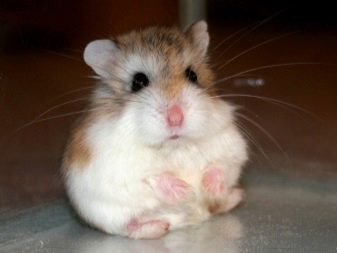

Roborovskiy's hamsters are considered to be fur-legged, their legs are covered with short hairs. The coat has a delicate golden sand color. Varieties with different colors of wool have been bred, but it is worth knowing that such crumbs have poor health. One litter may contain 3–6 babies. Representatives of this breed live up to 4 years.
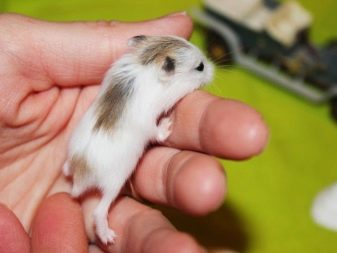

Selection recommendations
When purchasing a hamster at a pet store, you need to consider some of the nuances:
- the animal should be about 5-6 weeks old;
- the hamster should not be lethargic, half asleep, but you should not choose too lively;
- there is no need to buy a pet if there is at least some fear that it is unwell: hamsters do not respond well to treatment;
- the rodent's hair should be shiny and dry, without bald patches and wounds;
- there should be no growths and stray hairs on the skin;
- a healthy hamster's eyes are clean, without inflammation and abscesses;
- the nose should also be dry, without any discharge;
- teeth should not be overgrown.



Since hamsters do not live long, you need to choose a healthy pet in order to experience the pleasure of communicating with this cute baby as long as possible.
Care rules
When purchasing a dwarf hamster, it is worth remembering that for normal development it needs to create certain conditions and proper care. The first step is to select the appropriate cell. Despite the tiny size of a pet, it should be extensive.
The optimal spacing between the twigs is 7–8 mm, if the distance is greater, the hamster can escape.
Two-tier cages are becoming more and more popular, but then there is a possibility that an overly active baby will fall from the upper floor and damage himself.



In addition to the cage, you must also arm yourself with a running wheel, a rest house, labyrinths, and a drinking bowl. The litter should be made from sawdust or shavings. Little hamsters are very tidy animals, they clean their fur themselves, you do not need to wash them. For such procedures, you can put a bath with fine sand or a specially designed filler. The claws do not need to be processed, but if there are bent ones, they need to be carefully trimmed.

Receiving solid food for food, the animal grinds off its teeth, and if this is not enough, they can grow rapidly and cause discomfort to the animal. To prevent such a situation, a special stone must be placed in the cage, against which the hamster will file his teeth.


The cage should be cleaned 1-2 times a week, and the toilet should be cleaned as needed. It is better to allow the baby to walk in a walking ball: this way he will not run away and cannot damage anything.


Small hamsters should have a balanced diet. A special feed mixture must be present in their diet, it is advisable to give it in the evening, since hamsters are nocturnal animals and at this time are very active. They also eat fruits, vegetables, corn kernels, legumes; you can give fish or chicken breast. There should always be fresh water in the drinker. Spoiled residues must be cleaned up to avoid poisoning.
In addition, hamsters should not be given citruses, pomegranate seeds, kiwi, sweet and salty foods, and sausage. Nor should they be fed with bread, cabbage, melon and dairy products.



If it is planned to keep a male and a female together, they should be of the same breed and young - mature hamsters are prone to aggression.
The pregnant female needs to organize a protein-rich diet and vitamin supplements. Before giving birth, the female is moved to a separate cage, into which sawdust is poured. She makes a nest out of them.
Do not touch newborn cubs or scare the hamster - she can eat babies.
Little hamsters are bald, they can't see or hear anything. After 25-30 days, they can already be removed: boys and girls separately.

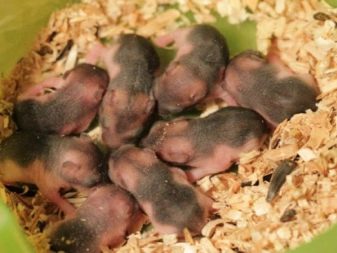
Unfortunately, dwarf hamsters often get sick. Signs that should alert you: disheveled fur, the animal itches, looks apathetic. The general symptoms of diseases are:
- smell;
- plentiful drink;
- lack or, conversely, excessive appetite;
- the wool acquires moisture;
- the eyes are watery, purulent discharge appears.


Most hamster illnesses are caused by improper care.
- Eye diseases are treated with chlorhexidine drops.
- Clogging of the cheek pouches occurs as a result of eating unhealthy foods. They are emptied, washed, and an antibiotic is applied.
- Bites are fairly common injuries in hamsters. The wounds should be washed and treated, and antibiotics should be used if necessary.
- Diseases of the gastrointestinal tract are best treated after examination by a veterinarian, and for prevention purposes, you should not experiment with nutrition.
- Hamsters grow teeth throughout their lives. If you do not give them the opportunity to scrub, they can grow too much and damage the oral cavity. In addition to solid food and crackers, animals need to be given a stone for grinding.
- Rodents can also be bothered by cystitis. It should only be treated by a veterinarian.
- Scabies is caused by the presence of a scabies mite.With this disease, the coat becomes wet, the skin itches and becomes covered with ulcers. The hamster is isolated, since the disease is contagious to humans, and is treated in a veterinary hospital.

To avoid illness, it is necessary to organize the appropriate care for the hamster and take responsibility for his duties. Then the dwarf hamster will bring joy and tenderness with its adorable appearance for a long time.
For everything you need to know when buying a hamster, see the next video.








